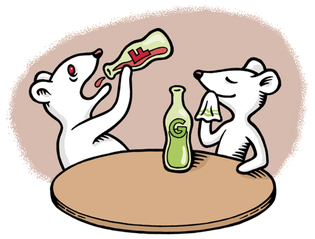 loading
loading
FindingsHow fructose tricks usOur brain misreads the sugar, leading us to overeat.  Gregory NemecView full imageFor some time now, medical researchers have suspected that fructose—the natural sugar that makes honey, fruit, and corn syrup sweet—is playing a major role in the US obesity epidemic. Fructose makes up about 10 percent of calories consumed in the nation. How exactly fructose relates to obesity has been a mystery, but new findings imply that it messes with our heads. A group of Yale researchers has found evidence that consuming fructose fails to curb the urge to eat. In a study recently published in the Journal of the American Medical Association, 20 healthy adults drank a solution of fructose and a solution of glucose. After each drink, the participants underwent functional MRIs to detect changes in blood flow (and, by extension, neuronal activity) in the brain. The two drinks produced very different effects. Glucose decreased blood flow in the hypothalamus—the brain’s appetite center—while increasing activity in regions that trigger satiety hormones, as well as in brain areas associated with reward and motivation. Fructose did neither. The bottom line: fructose doesn’t reduce appetite or make us feel full, and that means it might lead to overeating. “We knew that insulin and gut hormones have different responses to either sugar,” says coauthor Robert Sherwin, a professor of medicine and director of the Yale Center for Clinical Investigation. “But the comparison of the two sugars in the same individuals had not been done before.” Sherwin and pediatrics professor Sonia Caprio are now conducting a similar study of obese adolescents. Caprio, a specialist in childhood obesity, says that while more research is needed on the link between fructose and obesity, she anticipates warning labels on fructose-rich foods. “We’re going to have to make some policy changes,” she says.
The comment period has expired.
|
|